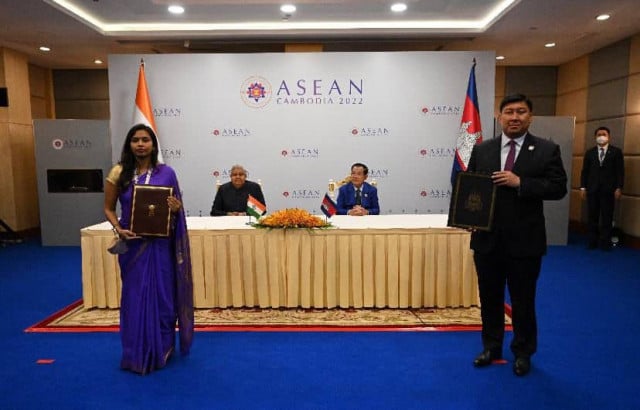Cambodia and India Engage in Wild Tiger Restoration

- By Teng Yalirozy
- November 15, 2022 3:15 PM
PHNOM PENH – Cambodia and India have signed a Memorandum of Understanding (MoU) to restore wild tigers, which were last seen in 2007 in Cambodia.
The document was signed on Nov. 12 by Cambodia’s Environment Ministry and India’s Ministry of Environment, Forest and Climate Change. It plans cooperation in biodiversity conservation and sustainable wildlife management, in addition to wild tiger conservation and restoration.
But no further details were given, neither on a timeline to begin reintroducing wild tigers nor on the number of animals who would be transferred from India to Cambodia.
It has nevertheless been agreed that India will provide wild tigers to Cambodia and promote cooperation to successfully protect them in the wild. The giving country will also share good conservation practices and exchange skills and capabilities to promote the conservation of wild tigers in both countries.
Environment Ministry Spokesperson Neth Pheaktra said this MoU opens the door for both countries to further technically and strategically discuss the reintroduction plan of wild tigers to the forest in Cambodia.
Pheaktra, however, said he cannot confirm when the tigers are to be imported nor the number of specimens that will be transferred. Yet, he expected this agreement will push forward the effort of Cambodia to restore its ecosystems, from tigers to prey and forests.
“Through this agreement, we will discuss further. The moment tigers will be sent will depend on the assessment and technical team of both countries,” he told Cambodianess on Nov. 15.
The Ministry’s spokesperson added that the tigers would be placed in the Cardamom Mountain rainforest while a technical team is studying the suitable habitat for the tigers to ensure that Cambodia provides a safe sanctuary for them.
An Indochinese tiger was last spotted by a camera trap in 2007 in Mondulkiri province. But no other picture has been captured since then.
In a move to revive the tiger population, the Cambodian government approved the Tiger Action Plan in 2016, a program that opens the door to a reintroduction of the species in the country, after acknowledging tigers were “functionally extinct”.
The plan is part of a worldwide initiative started in 2011 and named Tx2, involving 13 countries. Its initial goal was to double the number of wild tigers in the world by 2022, the Chinese year of the tiger.
The 13 countries being part of the program are now home to 4,652 tigers. An increase from 3,200 tigers identified in 2020, Seng Teak, WWF Cambodia country director said in July in Mondulkiri province, during the launch of the Zero Snaring Campaign, a government initiative aiming at crushing down illegal snaring.
Bhutan, China, and Russia have seen an increase in tigers, but not as much as Nepal and India. The number of tigers in Bangladesh and Thailand remained steady. On the contrary, it has decreased in Myanmar, Indonesia, and Malaysia, while Cambodia made no progress since 2007, the year the last wild tiger was seen.
To show a slight move in the right direction, Pheaktra announced that the team has prepared a 100-hectare-plot of land at the Cardamom Mountain area to place the tigers, hoping the animals would be sent as soon as the official document is signed.
The ministry has been cooperating with the World Wildlife Fund (WWF) and Wildlife Alliance to survey suitable habitats and restore enough prey to make sure that tigers, once imported to the country, survive in their new shelters.
But the selected area might be too small to accommodate the wild tigers. During the launching of the Zero Snaring Campaign, Mondulkiri Department of Environment Director Keo Sopheak explained that tigers need a 100-square-kilometer space to be comfortable in the wild, which is a hundred times more than the area being prepared by the Environment Ministry.
Neth Pheaktra added that the Zero Snaring Campaign is also an effort to increase the number of prey and provide a safe habitat for tigers.
According to the Ministry of Environment, 234,291 snares were removed between 2010 and 2019 in only five protected areas: Cardamom National Park, the Kulen Prum Tep, Keo Seima, Srepok, and Phnom Prich Wildlife Sanctuaries.
In 2021 alone, 61,611 snares were removed from 72 of Cambodia’s protected areas and biodiversity corridors which is an increase on the 10-year average of 40,000 per year.
Even though there are fewer snares in the woods of Cambodia than anticipated, the ministry warned that this still poses a serious threat to animals, particularly endangered species.















